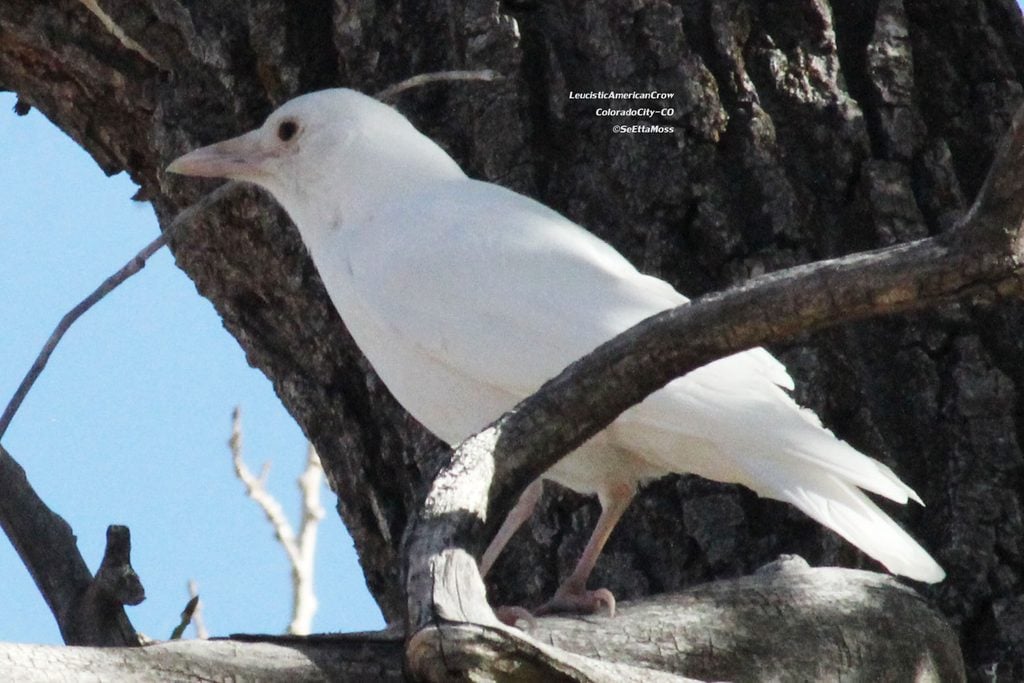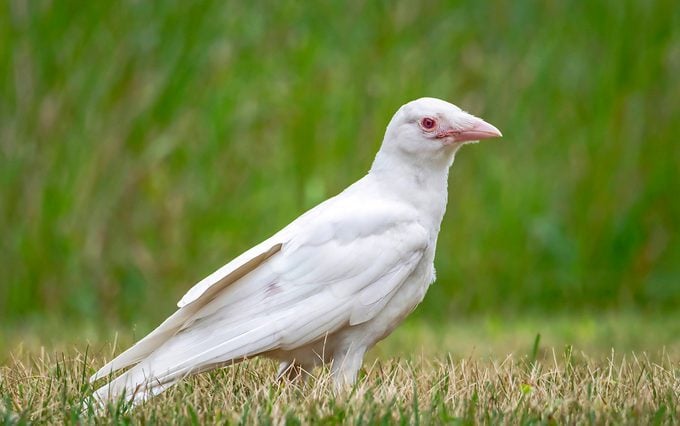Is This White Bird an Albino Crow?
Updated: Apr. 23, 2024
A white-feathered bird stands out from its flock—but is it an albino crow? Learn about what causes variations in a crow's colors.
On This Page
What Does an Albino Crow Look Like?

This American crow (above), photographed by Birds & Blooms contributor SeEtta Moss, has white feathers and pink feet, legs, and a pink bill…but that doesn’t necessarily make it an albino crow.
According to Kevin McGowan, senior course developer with the Cornell Lab of Ornithology, color variations in crows can occur for a variety of reasons. “Having a normal-plumaged bird is a complicated system,” he says, likening the factors that influence a bird’s coloring to starting a car. “If you turn your key and the car won’t start, there are a thousand things it could be.”
Certainly, one possibility is albinism, which occurs when the bird’s genetics result in cells that improperly produce melanin. This could turn the bird’s feathers white, and its skin pink. In such a case, the bird’s eyes would be also be red.
Are albino or leucistic robins rare?
Are Albino Crows Healthy?
Because plumage and feathers play key roles in a bird’s daily life and survival, albinism can be a detriment. It can affect the bird’s ability to find a mate, and even hurt the bird’s eyesight.
“True albinos don’t have any pigment in their eyes, so they’re very light-sensitive and probably can’t see as well as normal birds,” Kevin explains. He also highlights that melanin provides strength for feathers, which means the feathers of albino birds tend to be weaker than those of their normally colored counterparts. “There’s a reason albinism is rare,” he says. “It’s a bad condition to have.”
Is this white mourning dove albino?
Leucistic Crows
Aside from albinism, several other conditions or factors could cause a crow to lack coloring in its feathers or elsewhere on its body. One of the more common is leucism, also referred to as partial albinism.
“When a bird is developing as an embryo, we know there are mutations that can occur that mess with the distribution of melanocytes,” Kevin says, referencing cells that create melanin and deposit it throughout the bird’s feathers and skin. “Those birds have pure white patches scattered across the body, often symmetrically on each side. That’s because of bad distribution of the cells when the thing was developing. That’s called leucism.”
The white crow in the image above, then, appears to be leucistic.
See photos of rare white hummingbirds.
Other Causes of White Feathers

Albinism and leucism aren’t the only reasons a crow would develop unusually colored feathers. Sometimes, Kevin explains, external factors or age can play a role.
“There are things that can happen in the development of the feathers themselves, such that there’s something wrong with [the bird’s] nutrition, or they experience a deprivation in food, or there’s an illness or something that can interfere with the development of the melanin one time,” he says, explaining that it occurs frequently with juvenile crows. “That seems to be a developmental thing, a one-time accident sort of deal. The next year, they don’t have white in their feathers anymore.”
Meet the fish crow: the American crow’s coastal cousin.
Do Crows Turn Gray as They Age?
In addition, similarly to humans, older crows sometimes start to “go gray.” Rather than developing gray hairs like humans do, age affects the color of their feathers. “There’s progressive graying, which is that the cells that produce pigment die, and it’s like turning gray,” Kevin explains. “Certain cells can’t produce pigment anymore, and you end up with a bird that gets whiter and whiter.”
Another complicating factor: birds produce two kinds of melanin, and sometimes issues only occur with one. This can result in a bird that is grayer, or redder, than the others. “Sometimes we get gray crows that aren’t making the rusty brown melanin, and sometimes we get brownish crows that are not making the gray melanin,” Kevin says. “There can be gradations of that, and you can get some birds that are very pale. That’s called dilute plumage.”
Kevin has never personally seen an albino crow, although he has seen crows with variations in coloring. “It’s an interesting complex of things,” he says. “I’ve seen some very unique birds through the years. Not very often, but often enough to keep things interesting.”
Next, find out if crow sightings have meaning?
About the Expert
Lifelong birder and ornithologist Dr. Kevin McGowan is a senior course developer for the Cornell Lab of Ornithology’s Bird Academy. He earned a Ph.D in biology at the University of South Florida.
Sources
- Cornell Lab of Ornithology’s All About Birds, “What can cause birds to show weird color variations?“
- Project FeederWatch, “Albinism and Leucism“
Why Trust Us
For nearly 30 years, Birds & Blooms, a Trusted Media Brand, has been inspiring readers to have a lifelong love of birding, gardening and nature. We are the #1 bird and garden magazine in North America and a trusted online resource for over 15 million outdoor enthusiasts annually. Our library of thousands of informative articles and how-tos has been written by trusted journalists and fact-checked by bird and garden experts for accuracy. In addition to our staff of experienced gardeners and bird-watchers, we hire individuals who have years of education and hands-on experience with birding, bird feeding, gardening, butterflies, bugs and more. Learn more about Birds & Blooms, our field editor program, and our submission guidelines.
